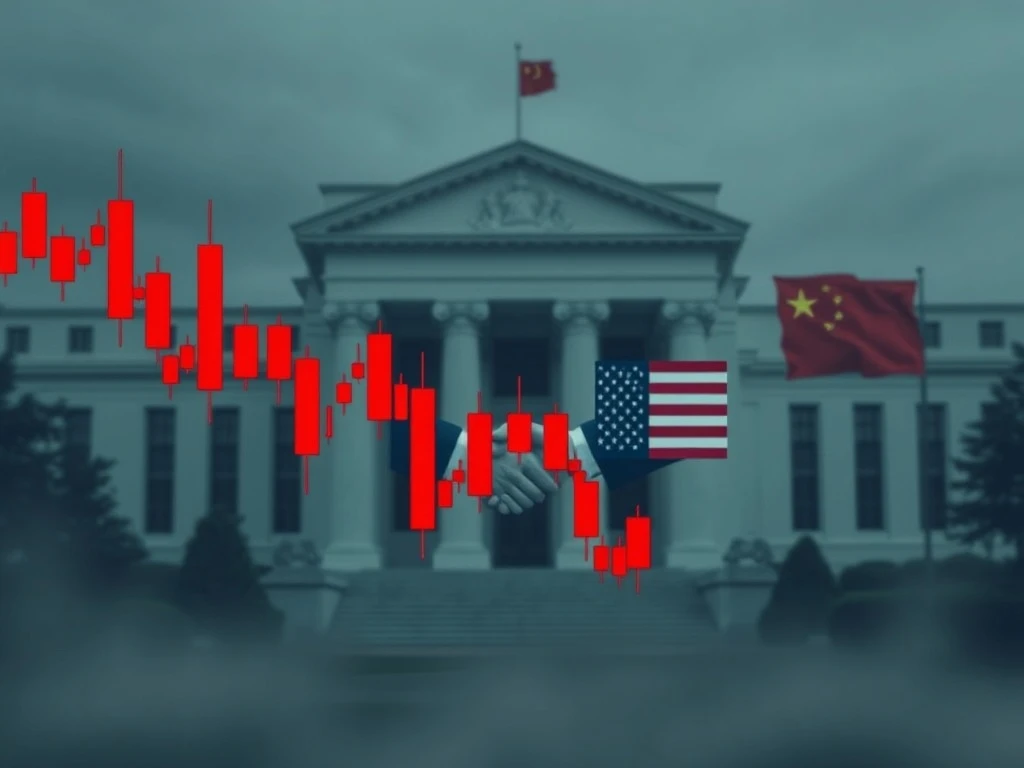Crypto Market Plunge: Fed Uncertainty and Trade Hopes Fail to Halt Bitcoin’s Decline

The crypto market is currently navigating a challenging period. Recent data shows a significant downturn in prices, sparking concern among investors. This comes despite traditionally positive signals, such as easing trade tensions and a modest interest rate cut. What factors are truly driving this recent Bitcoin price slump and broader market weakness? Understanding these dynamics is crucial for anyone involved in digital assets.
Federal Reserve’s Stance Creates Market Uncertainty
Recent developments from the Federal Reserve have cast a shadow over financial markets. On Thursday, the Federal Open Market Committee (FOMC) meeting concluded. Federal Reserve Chair Jerome Powell’s comments specifically contributed to market jitters. He noted that FOMC members hold “strongly differing views” about a potential December interest rate cut. This lack of consensus created immediate investor uncertainty.
The Fed did slash interest rates by 25 basis points. However, this move did not provide the expected market relief. Powell’s remarks on monetary policy direction remained unclear. This ambiguity left many investors feeling uncertain about the future economic landscape. Furthermore, the Federal Reserve signaled the end of quantitative tightening (QT).
Quantitative tightening restricts liquidity within the financial system. Historically, higher liquidity acts as a positive catalyst for crypto prices. However, a typical gap exists between the end of QT and the start of quantitative easing (QE). QE involves actively pumping liquidity into the financial system. Therefore, crypto prices could sink further until these liquidity injections begin.
Geopolitical Shifts: US-China Trade Negotiations
In a separate but significant development, US Treasury Secretary Scott Bessent made an important announcement. On Thursday, he stated the US would suspend restrictions. These restrictions previously limited Chinese companies’ access to sensitive US technology. This easing of controls came in exchange for China’s agreement. China will suspend its export controls on rare earth minerals. Reuters reported this reciprocal agreement. These minerals are vital for electronics and military defense applications.
Bessent’s announcement followed several weeks of softening trade tensions. Relations between the two global powers had been improving. Normally, such positive trade news acts as a strong catalyst for crypto prices. Yet, the recent Federal Reserve meeting overshadowed these geopolitical gains. The market’s focus shifted back to domestic monetary policy and its immediate implications.
Bitcoin Price Plummets Amidst Mass Liquidations
The impact of these combined factors became evident across the crypto market. Most cryptocurrencies traded in the red on Thursday. Source: TradingView
The crypto market is mostly in the red on Thursday. Source: TradingViewThe price of Bitcoin experienced a notable decline. It fell below $107,000. It also breached its 200-day exponential moving average (EMA). Data from Nansen identifies this as a critical and dynamic support level. This breach often signals further potential downside for the asset.
Moreover, the crypto derivatives market saw massive liquidations. Over $1.1 billion was liquidated in just 24 hours. Source: CoinGlass
Liquidations in the crypto derivatives market top $1 billion in 24 hours. Source: CoinGlassThis surge in liquidations underscores the high leverage and volatility in the market. It also highlights the rapid investor response to perceived negative news. The magnitude of these liquidations reflects significant investor fear and uncertainty. The historical context also adds to current concerns.
In 2019, the price of Bitcoin fell by 35%. This occurred after the Federal Reserve ended its previous round of quantitative tightening. Investors now fear a similar scenario. This historical precedent fuels concerns during the current market cycle.
Inflation and the Fed’s Challenging Dual Mandate
Federal Reserve Chair Jerome Powell addressed the media on Wednesday. His comments at the FOMC press conference provided further insights. Source: Federal Reserve
Federal Reserve Chair Jerome Powell addresses the media in Wednesday’s FOMC press conference. Source: Federal ReservePowell acknowledged that inflation has eased significantly. It has dropped from its highs in mid-2022. However, it still remains somewhat elevated. It sits above the Fed’s 2% target goal. The FOMC is struggling to balance its dual mandate. This mandate includes achieving maximum employment and stable pricing. This balancing act presents ongoing challenges.
Powell emphasized the divergent opinions among FOMC members. “There were strongly differing views about how to proceed in December,” he stated. He further clarified that a December policy rate reduction is “not a foregone conclusion — far from it.” He concluded, “Policy is not on a preset course.” This statement reinforced the unpredictability of future monetary policy decisions. Such uncertainty typically deters risk-on assets like cryptocurrencies.
Navigating the Current Crypto Market Downturn
The confluence of these factors has created a challenging environment. The crypto market is currently grappling with significant headwinds. Macroeconomic uncertainty, driven by the Federal Reserve’s cautious stance, plays a major role. Geopolitical positivity from US-China trade talks was simply not enough. It could not offset the prevailing economic concerns. The immediate future for liquidity also remains a key factor.
Until active liquidity injections commence, the market could face further pressure. Investors are closely watching for clearer signals from the Fed. The historical precedent of quantitative tightening impacts is a stark reminder. This period demands careful consideration and a thorough understanding of underlying economic forces. The market remains highly sensitive to both monetary policy shifts and global economic sentiment.








